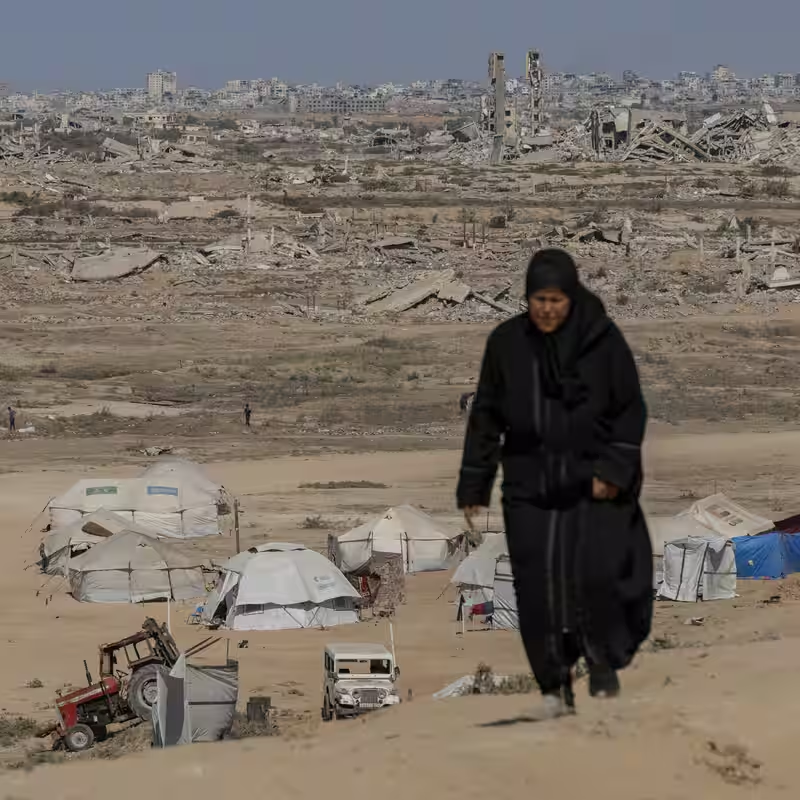Table of Contents
- The ‘Yellow Line’ Divide
- U.S.-Backed Reconstruction Plan
- Skepticism on the Ground
- Security and Occupation Concerns
- Palestinian Perspectives
- Sources
The ‘Yellow Line’ Divide
Following a fragile cease-fire in October 2025, Gaza is now split in two—literally. A boundary known as the “yellow line” cuts through the enclave, separating the eastern 53% under Israeli military control from the western half still governed by Hamas. The division, marked by yellow-painted concrete blocks, has turned half of Gaza into a near-empty wasteland patrolled only by soldiers.
Israeli authorities have warned Palestinians against entering the eastern zone. Those who have crossed—sometimes by accident—have reportedly been killed. Meanwhile, roughly 30,000 civilians remain in parts of Rafah and Khan Younis within the Israeli-controlled area, permitted only to leave, not return.
Gaza Rebuild Plan Gains U.S. Momentum
American officials, including Vice President JD Vance and former Trump advisor Jared Kushner, are championing a bold—and controversial—idea: rebuild the Israeli-held half of Gaza immediately, without waiting for Hamas to be fully disarmed.
“Take the areas where Hamas is not operating, start to rebuild very quickly,” Vance said during a recent visit to Israel. Kushner echoed the sentiment, envisioning “a new Gaza” rising from the rubble—complete with jobs, housing, and security, but crucially, no Hamas influence.
The Gaza rebuild plan targets infrastructure, housing, and economic revival in the east, with the hope of creating a model Palestinian community that poses no threat to Israel. Proponents argue it could prevent Hamas from regaining footholds in cleared zones—a mistake they say Israel repeated during earlier phases of the war.
Skepticism on the Ground
Despite its appeal in Washington and Tel Aviv, the Gaza rebuild plan faces deep skepticism among Palestinians and regional experts. Many see it as impractical—or worse, a thinly veiled land grab.
“Too many people talk about us like we’re chess pieces,” said Mohammed Fares, 25, a displaced resident of Gaza City. “They think we can just be moved from one space to another.”
Ayed Abu Ramadan, chairman of the Gaza Governorate Chamber of Commerce, questioned the logic of rebuilding on agricultural and industrial land currently under Israeli control. “They’re going to build residential structures there? That isn’t logical,” he said.
Security and Occupation Concerns
Even if reconstruction begins, keeping Hamas out may require draconian measures. Tamir Hayman, former chief of Israeli military intelligence, warned that maintaining a Hamas-free zone would demand “24/7 screening,” checkpoints, and military outposts—features that critics say amount to a new form of occupation.
“If you call it a new form of occupation of Gaza, you might be right,” Hayman admitted. He added that Hamas would likely attempt to infiltrate or launch attacks within the rebuilt zone to undermine its legitimacy.
Arab nations are also wary. Any involvement in a project perceived as legitimizing Israeli control could spark domestic backlash or damage regional diplomacy.
Palestinian Perspectives: Roots Over Relocation
For most Gazans, the idea of relocating—even to newly built homes—is a nonstarter. Two million people have been displaced multiple times over two years of war. Yet their attachment to ancestral neighborhoods remains unshaken.
“I don’t see any benefit to this program,” Fares said. “We want to rebuild our homes in Gaza City. My roots are there.”
Others fear the plan could fracture families. “They’ll say certain people can’t go because there are question marks about them,” Abu Ramadan warned, citing arbitrary security screenings based on phone calls, handshakes, or distant relatives.
Without genuine Palestinian buy-in—and a political path toward self-determination—the Gaza rebuild plan risks becoming another well-intentioned but doomed U.S. initiative in the region.
Sources
The New York Times: “A Quick Route to Rebuild Half of Gaza, or Another U.S. Pipe Dream?”




